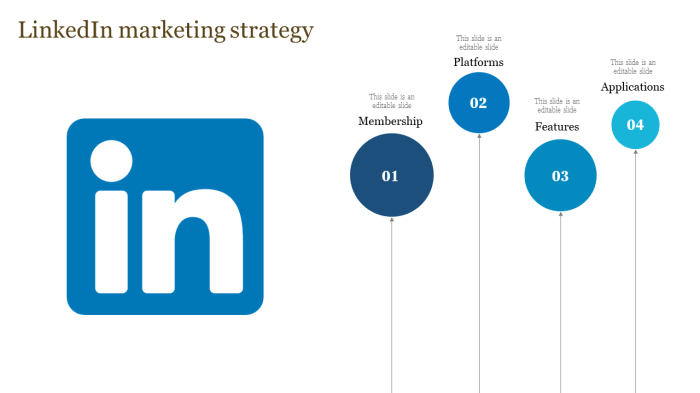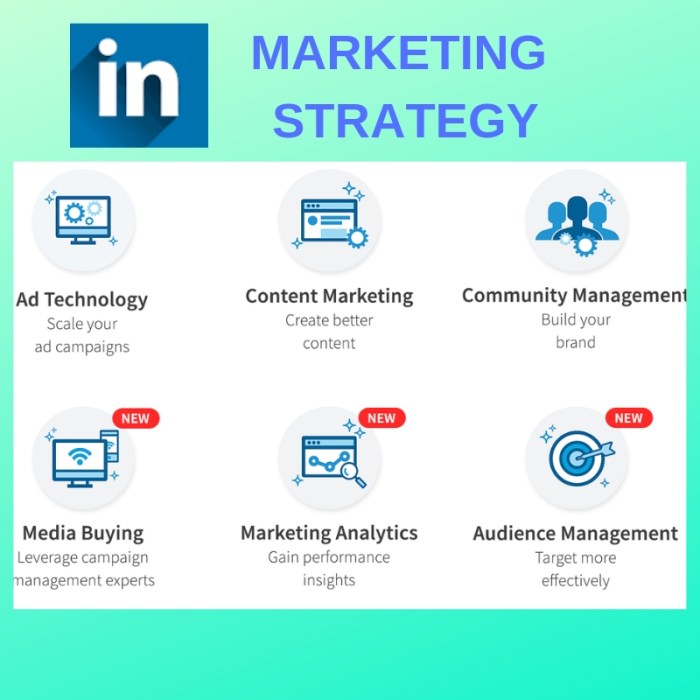Building a LinkedIn Marketing Strategy is crucial for businesses looking to expand their reach and connect with professionals in their industry. From setting objectives to creating engaging content, this comprehensive guide will walk you through the essentials of crafting a successful LinkedIn marketing strategy.
Overview of LinkedIn Marketing Strategy
LinkedIn has become a powerhouse in the world of business marketing, offering a unique platform for professionals to connect, engage, and promote their brands. With over 700 million users worldwide, LinkedIn provides a valuable opportunity for businesses to reach a targeted audience of decision-makers and industry influencers.
A well-crafted LinkedIn marketing strategy can benefit businesses in numerous ways. It can help increase brand visibility, establish thought leadership, generate leads, and drive website traffic. By leveraging the platform’s features effectively, businesses can create meaningful connections, showcase expertise, and build credibility within their industry.
Key Components of a LinkedIn Marketing Strategy
- Create a Compelling Company Page: Your company page serves as the foundation of your LinkedIn presence. Make sure it is complete, visually appealing, and optimized with relevant s.
- Develop Engaging Content: Share valuable content that resonates with your target audience, such as industry insights, case studies, and thought leadership articles.
- Build a Strong Network: Connect with industry professionals, clients, and partners to expand your reach and establish meaningful relationships.
- Utilize LinkedIn Ads: Consider using LinkedIn’s advertising options to target specific audiences, promote content, and drive conversions.
- Analyze and Optimize: Regularly monitor your performance metrics, such as engagement rates and lead generation, to fine-tune your strategy for better results.
Setting Objectives
Setting clear objectives is crucial in a LinkedIn marketing strategy as it helps to focus efforts, measure success, and stay aligned with overall business goals. Without clear objectives, it can be challenging to track progress and determine the effectiveness of the marketing efforts.
Importance of Setting Clear Objectives
- Provides a clear direction for the marketing campaign
- Helps in measuring the success and ROI of the LinkedIn marketing efforts
- Allows for better alignment with overall business goals
- Aids in setting specific targets and milestones for the campaign
Common Objectives for LinkedIn Marketing Campaigns
- Increase brand awareness and visibility
- Generate leads and drive website traffic
- Build relationships with industry influencers
- Showcase thought leadership and expertise in a specific field
Aligning LinkedIn Marketing Objectives with Business Goals
To align LinkedIn marketing objectives with overall business goals, it is important to first identify the key objectives of the business. Once these objectives are clear, the LinkedIn marketing objectives can be tailored to support and complement them. For example, if the business goal is to increase sales by 20%, the LinkedIn marketing objective could be to generate a certain number of leads through the platform to contribute to this overall sales target.
Target Audience Identification: Building A LinkedIn Marketing Strategy
Identifying the target audience is crucial for a successful LinkedIn marketing strategy. By understanding who your audience is, you can tailor your content to resonate with them, increase engagement, and ultimately drive conversions.
Methods to Analyze and Define Target Audience
- Utilize LinkedIn Analytics: Use LinkedIn Analytics to gather data on your followers, including demographics, interests, and behaviors.
- Conduct Surveys: Send out surveys to your existing LinkedIn connections to gather insights on their preferences and needs.
- Competitor Analysis: Look at your competitors’ LinkedIn profiles to see who is engaging with their content and identify potential target audience segments.
- Use Buyer Personas: Develop detailed buyer personas based on research to understand the needs, pain points, and motivations of your target audience.
Tailoring Content Based on Target Audience
- Personalize Messaging: Craft content that speaks directly to the needs and interests of your target audience to establish a connection.
- Use Relevant s: Incorporate s that resonate with your target audience to improve the visibility of your content.
- Create Engaging Visuals: Utilize images, videos, and infographics that appeal to your target audience to enhance engagement.
- Share Valuable Insights: Provide valuable industry insights and thought leadership content that addresses the pain points of your target audience.
Content Strategy
Creating a solid content strategy is crucial for a successful LinkedIn marketing campaign. Your content should be informative, engaging, and tailored to your target audience to drive results. Here are some key elements to consider:
Types of Content for LinkedIn
- Articles: Share industry insights, thought leadership pieces, and company updates to showcase your expertise.
- Visual Content: Images, infographics, and videos grab attention and increase engagement on the platform.
- Company Updates: Share news, product launches, and team achievements to keep your audience informed.
- Employee Stories: Highlight your team members’ accomplishments, work culture, and behind-the-scenes moments to humanize your brand.
Tips for Creating Engaging Content
- Know Your Audience: Tailor your content to address the pain points and interests of your target audience.
- Use Rich Media: Visual content performs well on LinkedIn, so include images, videos, and infographics in your posts.
- Ask Questions: Encourage interaction by asking questions in your posts to spark conversations with your audience.
- Provide Value: Share valuable insights, tips, and industry news to position your brand as a trusted resource.
- Optimize for LinkedIn: Use relevant hashtags, tag relevant companies or individuals, and optimize your content for the LinkedIn audience.
Building a Network
Building a strong network on LinkedIn is crucial for the success of your marketing strategy. A robust network can help you reach a wider audience, establish credibility, and generate leads effectively.
Strategies for Expanding Connections
Expanding your connections on LinkedIn involves more than just sending out random connection requests. Here are some strategies to help you grow your network:
- Connect with colleagues, clients, industry peers, and thought leaders in your field.
- Join LinkedIn groups relevant to your industry and actively participate in discussions.
- Attend networking events and conferences to meet potential connections in person.
- Utilize LinkedIn’s “People You May Know” feature to discover new connections.
Engaging with Connections Effectively
Once you have built a network on LinkedIn, it’s essential to engage with your connections effectively to enhance your marketing strategy. Here are some tips for engaging with your connections:
- Share relevant and valuable content regularly to keep your connections informed and engaged.
- Interact with your connections’ posts by liking, commenting, and sharing to show your support and build relationships.
- Personalize your messages when reaching out to connections to make the communication more meaningful.
- Offer help, advice, or resources to your connections when needed to establish yourself as a valuable connection.
LinkedIn Advertising

LinkedIn advertising plays a crucial role in a comprehensive marketing strategy by helping businesses reach a targeted audience, increase brand awareness, and drive conversions. With a variety of ad formats and targeting options, LinkedIn provides a powerful platform for businesses to showcase their products or services to a professional audience.
Types of LinkedIn Ads and Their Benefits
- Sponsored Content: These ads appear directly in the LinkedIn feed and are great for boosting brand visibility and engagement.
- Text Ads: These are simple, cost-effective ads that appear on the side or top of the LinkedIn feed, ideal for driving traffic to a website or generating leads.
- Sponsored InMail: These personalized messages are sent directly to users’ inboxes, making them effective for reaching a targeted audience with targeted messaging.
Best Practices for Creating and Managing LinkedIn Ad Campaigns:
- Set clear objectives for your ad campaign to measure success.
- Target specific audience segments based on job title, industry, company size, etc., to ensure your ads reach the right people.
- Create compelling ad copy and visuals that resonate with your target audience and include a strong call-to-action.
- Monitor ad performance regularly and make adjustments based on data to optimize campaign results.
Analytics and Monitoring

Analytics and monitoring play a crucial role in measuring the effectiveness of your LinkedIn marketing strategy. By analyzing data and insights, you can make informed decisions and optimize your approach for better results.
Significance of Analytics
Utilizing analytics allows you to track key metrics and performance indicators to gauge the success of your LinkedIn marketing efforts. It provides valuable information on engagement, reach, and conversions, helping you understand what is working and what needs improvement.
Setting Up LinkedIn Analytics Tools
Setting up LinkedIn analytics tools is essential to access valuable data about your audience and campaign performance. You can use LinkedIn’s built-in analytics dashboard to track metrics such as impressions, clicks, and engagement. Simply navigate to your company page and click on the Analytics tab to get started.
Tips for Monitoring and Adjusting Strategy, Building a LinkedIn Marketing Strategy
- Regularly review your analytics data to identify trends and patterns in performance.
- Compare different campaigns and content types to see what resonates best with your audience.
- Adjust your strategy based on data insights, focusing on tactics that drive the most engagement and conversions.
- Experiment with A/B testing to refine your approach and optimize for better results.
- Stay updated on new features and tools within LinkedIn’s analytics platform to leverage the latest capabilities for your marketing strategy.












